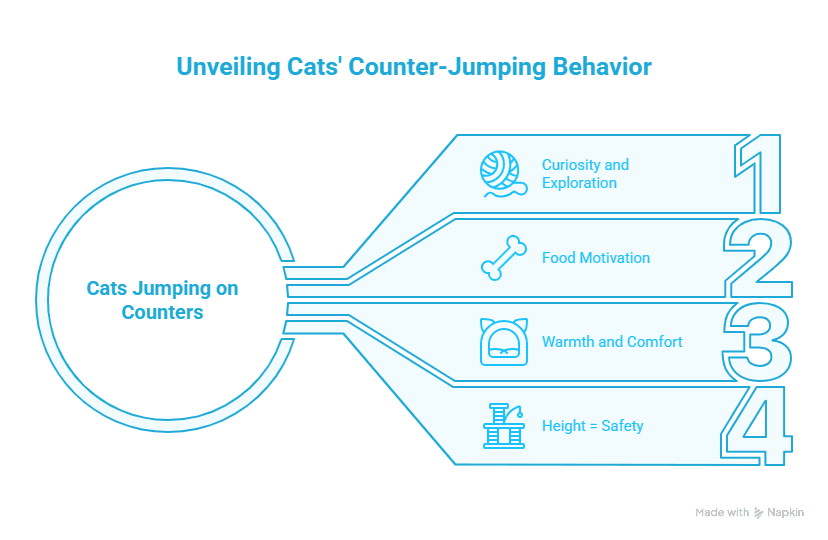
Introduction
You love your cat. You really do.
But do you love seeing them leap onto the kitchen counter, where you prep your meals, store groceries, and try to maintain a germ-free zone? Probably not.
Whether it’s the sound of paws hitting granite or the unmistakable sight of a tail near your toaster, one thing is clear: cats and countertops don’t mix well, at least not for most cat parents.
Still, cats are clever, curious, and known for doing things on their terms. So the big question is:
How to train a cat to stay off the counter—without yelling, spraying, or losing your mind?
You’re in the right place. Let’s walk through everything you need to know to understand why your cat does it—and how to gently, effectively, and permanently help them stop.
Why Do Cats Jump on Counters in the First Place?

Before you can change a behavior, you have to understand it. Cats aren’t being defiant when they jump on counters—they’re following instinct, curiosity, and environmental cues.
Here’s what draws them up there:
🐾 1. Curiosity and Exploration
Cats are naturally inquisitive. A counter is just another “high ground” to investigate—and often has new sights, scents, or textures to explore.
🍗 2. Food Motivation
Crumbs, spills, and even the smell of a used pan can attract your cat like a magnet. If they’ve found food up there even once, it becomes a place of reward.
☀️ 3. Warmth and Comfort
Counters often sit near heat sources—stoves, windows, and appliances. Warmth-seeking cats are especially drawn to these cozy zones.
📏 4. Height = Safety
Cats instinctively seek elevation. Higher spaces offer security, better views of their territory, and distance from perceived threats (even if it’s just the dog or toddler).
💡 5. Learned Behavior
If jumping on the counter gets them attention, treats, or access to things they want—even once—it’s reinforced. Even a scolding can be interpreted as engagement.
Should You Let Your Cat on the Counter?
This is up to you, but consistency is critical. Some people are okay with cats on counters, while others find it unsanitary or annoying.
❌ Reasons to Say “No”:
- Hygiene: Cats step in their litter box. Enough said.
- Safety: Hot stoves, sharp knives, and glassware pose real risks.
- Boundaries: It’s hard to set limits in one room if “everything goes” in another.
If you’re reading this article, you likely prefer your counters to be cat-free, and that’s completely valid.
How to Train a Cat to Stay Off the Counter (Without Losing Their Trust)
Now let’s dig into the training process. The key is combining deterrents, redirection, and positive reinforcement—never punishment.
✅ Step 1: Remove the Reward
Your cat jumps on the counter and finds… nothing. No food. No water. No fun. Over time, the habit weakens.
Actions:
- Wipe down counters after cooking
- Keep all food sealed and stored
- Never feed your cat near or on the counter
- Avoid leaving dirty dishes in the sink
Remember: Cats are opportunists. If they find nothing exciting, they’ll stop checking.
✅ Step 2: Make the Counter Less Appealing
Cats don’t love walking on uncomfortable, sticky, or unstable surfaces. Use that to your advantage.
Safe Deterrents:
- Aluminum foil: Many cats dislike the crinkly feel and sound
- Double-sided tape: Try Sticky Paws (safe, cat-friendly)
- Plastic carpet runners (spike side up)
- Motion-activated air spray (e.g., Ssscat)
- Citrus or apple cider vinegar spray: Use diluted and test for staining
Note: These are temporary tools. Once the habit is broken, you can remove them.
✅ Step 3: Redirect with Acceptable Alternatives
This is the most important step: give your cat a better option. If your cat wants height or attention, you need to offer that elsewhere.
Great Alternatives:
- Tall cat trees (place near windows)
- Wall-mounted shelves or “cat highways”
- Window hammocks
- Cat-safe kitchen stool or perch (if you want them near)
Every time your cat chooses their tree instead of the counter, reward them.
✅ Step 4: Use Positive Reinforcement
Cats respond to rewards, especially ones tied to behavior.
What to do:
- Use a clicker or marker word (“Yes!”) when your cat uses an approved surface
- Follow up with a high-value treat, praise, or play
- Never punish—just ignore and redirect
Over time, your cat will learn: Climbing on the tree = treats. Jumping on the counter = nothing.
✅ Step 5: Limit Access When You’re Not Watching
If your cat only jumps on the counter when you’re gone, it’s a habit reinforced by opportunity.
Strategies:
- Close kitchen doors if possible
- Use baby gates or folding panels
- Remove chairs or stools they use to climb
- Place temporary deterrents on counters when away
Breaking the routine when you’re out of sight helps reshape the behavior faster.
What Not to Do
The internet is full of questionable advice. Avoid these outdated or harmful tactics:
❌ 1. Spraying Your Cat with Water
While it might work short-term, it builds fear, not trust. Your cat may just wait until you’re not looking.
❌ 2. Yelling or Physical Punishment
This damages your bond and does not teach your cat what to do instead.
❌ 3. Pushing or Grabbing Them Off the Counter
They may become defensive—or worse, associate you with stress.
Stick with gentle redirection, consistency, and making the wrong choice unrewarding, not scary.
Tools That Actually Help
You don’t need fancy gadgets, but a few smart tools can make the process easier.
🛠️ Top Tools:
- Ssscat Motion Sensor Air Spray – Startles cats with a harmless puff
- Sticky Paws Tape – Easy to apply and remove
- Tall Cat Tree with Perches – Encourage vertical exploration elsewhere
- Clicker and Treats – Reinforce positive behavior
- Window Shelf – Satisfy their need to look outside without the countertop
What If My Cat Is a Stubborn Counter-Hopper?
Some cats are persistent, especially those motivated by food or attention.
Additional Tips:
- Feed your cat before cooking to reduce food interest
- Use interactive toys during prep times to distract
- Try puzzle feeders in another room
- Provide a cat-safe kitchen perch so they can “supervise” without being in the way
Also, check for underlying reasons like:
- Boredom
- Anxiety
- Hunger due to low-calorie diets
Training Kittens vs. Adult Cats
🐱 Kittens
- Easier to train early
- Still exploring the rules
- Reward new behaviors as they happen
🐈 Adult Cats
- Habits are more ingrained
- May need longer adjustment period
- Be patient and consistent—change takes time
FAQs
Why does my cat only jump on the counter when I’m not around?
They’ve learned it’s safe when unsupervised. Use deterrents or limit access during those times.
Is it harmful to let my cat on the counter sometimes?
It depends on your preference, but inconsistency can confuse your cat and make training harder.
Can aluminum foil really keep cats off counters?
For many cats, yes! They dislike the texture and sound. But it doesn’t work for every cat.
My cat loves the warm counter by the window—what should I do?
Provide a nearby warm perch or window hammock instead. Reward them for using it.
Also Read - Why Does My Cat Sleep Between My Legs? Understanding Your Cat’s Cozy Habit
Conclusion
Training your cat to stay off the counter doesn’t require yelling, spraying, or giving up.
It simply requires:
- Understanding their motivation
- Removing the reward
- Providing a better alternative
- Reinforcing the right choices consistently
Remember: your cat isn’t being “bad”—they’re being a cat.
With a little patience and a lot of love, you can teach them what you want, without sacrificing the bond you’ve built together.Because the truth is, a cat who feels secure, stimulated, and respected?
That’s the kind of cat who’ll choose the tree over the counter every time.




